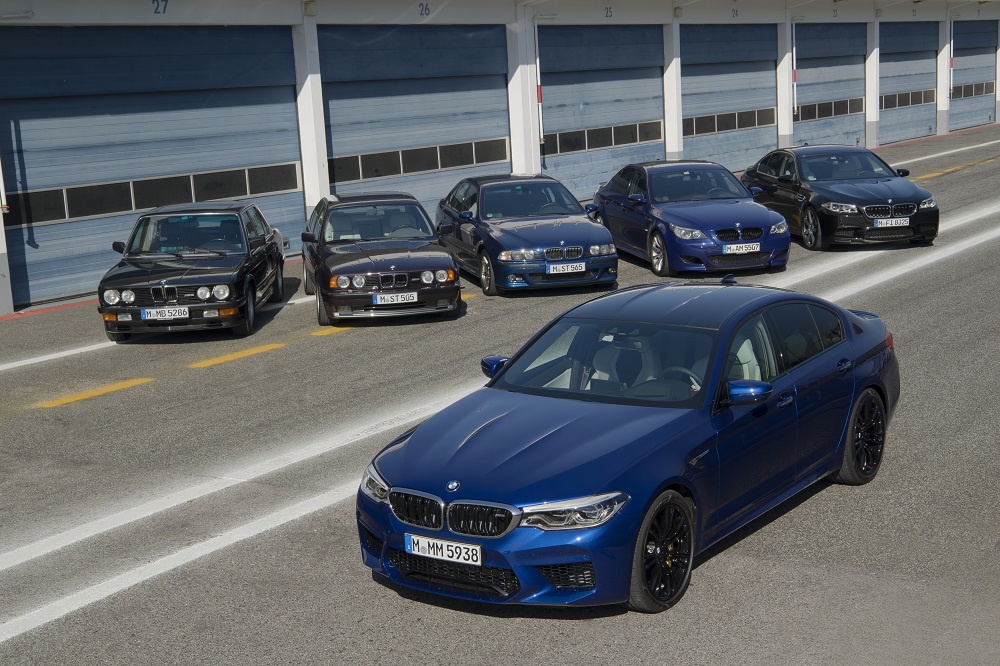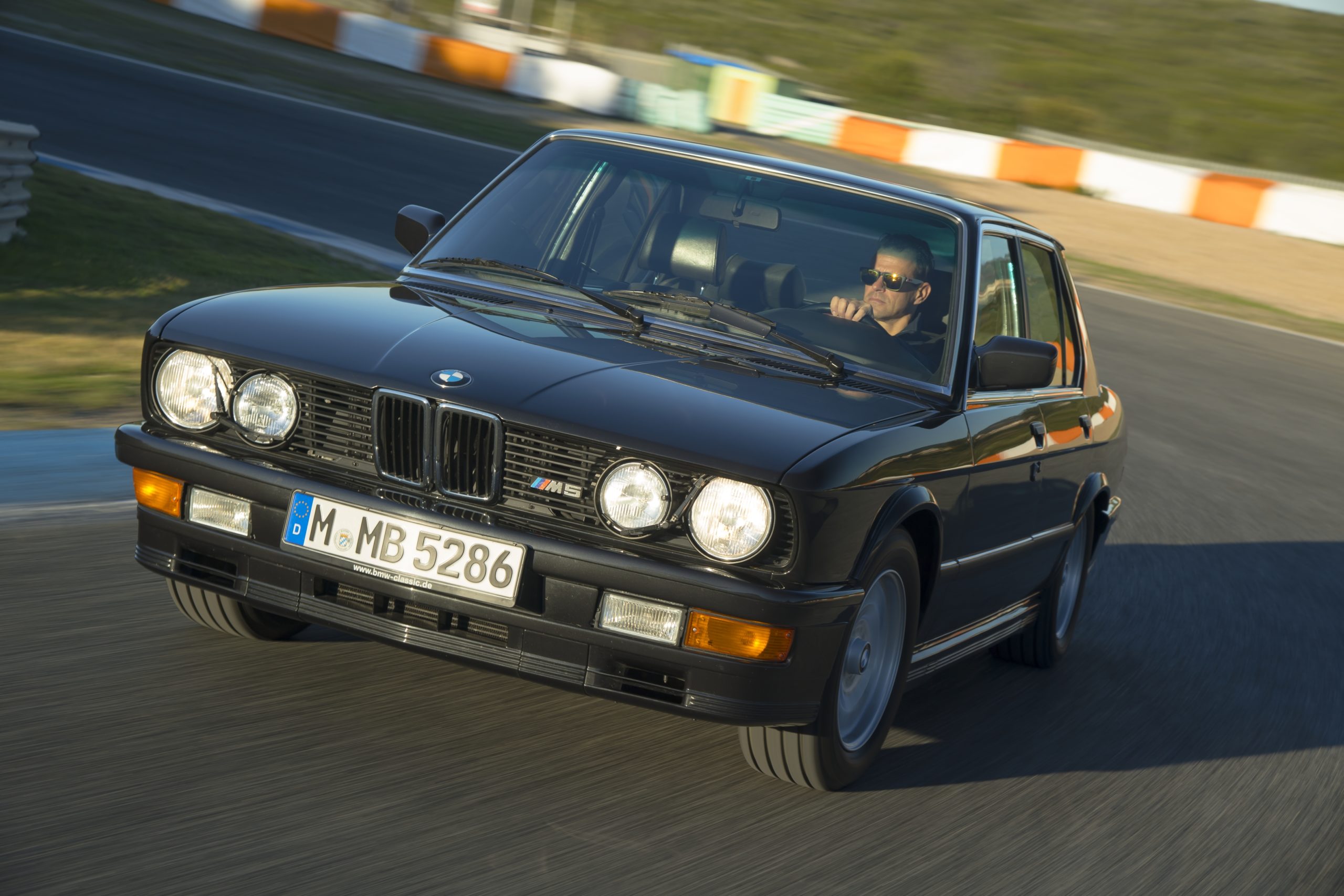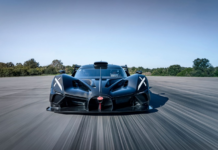How many doors is a sports car allowed to have? In the late summer of 1984, BMW Motorsport GmbH found a completely new answer to this question and mounted the extremely muscular six-cylinder engine from the mid-engined BMW M1 high-powered car into a four-door saloon of the BMW 5 Series. The BMW M5 was born and with it the segment of high-power saloons with the character of a sports car.

Sheer power came together with pure understatement. The sixth generation of the BMW M5 has now lined up on the starting grid –or in the car park at the supermarket, or even in front of a holiday home. The successful basic principle has remained unchanged. The BMW M5 moves around in everyday traffic as masterfully as on the race track.
33 years and 314 hp have elapsed between the first BMW M5 and the current version. In spite of the big difference in power, there are a lot of similarities. Then as today, the BMW M5 combines engine and chassis engineering from motor sport with the comfort and functionality of a four-door automobile. The technology used in the vehicle changes from generation to generation, but the character of the BMW M5 remains constant. The automobile is defined by engines which transform their power spontaneously into thrust over an extended period of time and by a chassis that guarantees precisely controllable handling up to the boundaries of physical limits even with an extremely sporty driving style. Delving into the history of high-performance saloons demonstrates how this concept came into being and shows how it has undergone a process of continuous development.
In the beginning was –the engine. An inline six-cylinder engine with displacement of 3.5 litres and four-valve engineering. Until 1978, the engine propelled the BMW M1 mid-engined sports car –with 277 hp for the road-going version and up to 850 hp in racing competitions. When production of the M1 was discontinued, the engine embarked on its second career. In 1983, it began a new journey powering the BMW 6 Series coupé, which went on to enthuse fans as the BMW M635CSi. Then the engineers set their sights on the BMW 5 Series saloon, which had been designed on the same platform. Was it possible to do the same with a classic saloon . . .? You certainly could.

“The chassis always needs to be faster than the engine.”
Positioning the inline six-cylinder engine under the engine bonnet of the four-door saloon was a challenge. But the experts at BMW Motorsport GmbH completed the masterpiece when they met the challenge of applying the power on the road after it had been enhanced to 286 hp. “The chassis always needs to be faster than the engine,” was already their guiding principle back then, and accordingly the BMW M5 was given tauter springs alongsidea strengthened five-speed gearbox, mono-tube gas-pressure shock absorbers, a slightly lower-slung chassis, reinforced and bigger brakes, a special ABS system, lightweight alloy wheels and wide tyres with reinforced flanks. The entire automobile was tuned to the North Loop of the Nürburgring, where every new BMW M model has to pass its tyre test to this day.
There were few external traces of the fitness upgrade. Anybody who thought the wide tyres were perhaps special accessories might well think thatthey had the basic model of the 5 Series in front of them or behind them, rather than the M5 which was almost three times as powerful. Only small model lettering on the front apron provided an indication of the extraordinary power.
From “invisible sports car” to “businessman’s express”.
The subtle appearance soon gave the BMW M5 a reputation of being the “invisible sports car”. Later on this was followed by the epithet of “businessman’s express”. This provided a clear indication of what type of customer was interested in a saloon that took 6.5 seconds to accelerate in the sprint from a standing start to 100 km/h. Understatement as far as appearance was concerned characterised all the generations of the BMW M5. The second M5 launched in 1988 was no exception with an initial output of 315 hp and then 340 hp from 1991 onwards. Almost unnoticed, it sprinted to 100 km/h in just 5.9 seconds. The BMW M5 touring arrived in 1992 with even less grandeur. An adaptive M chassis with electronically controlled dampers assisted the two automobiles in further enhancing the level of comfort and agile handling. But as the power increased further, the body styling required to optimise the flow of cooling air and the aerodynamics became increasingly difficult to conceal. The third edition of the M5 launched in 1998 already required significantly larger cooling air inlets for its new V8 engine generating 400 hp. For the first time, two twin tailpipes at the rear gave an indication of the enhanced potential that was reflected in the sprint time of 5.3 seconds.
In 2004, the fourth generation made a veritable quantum leap with a ten-cylinder engine derived directly from Formula 1. Thanks to the engine’s 507 hp, only 4.7 seconds were required for the standard sprint. Inaddition, the V10 took the high-revving concept of M engines to the limit: with 8250 revolutions and an impressive sound backdrop. But there were no changes to the everyday capability of the BMW M5. And so the M engineers developed another BMW M5 touring.

Turbocharger and M xDrive ascend to new dimensions of dynamic driving.
In 2011, the return to the V8 engine in the fifth generation of the BMW M5 was associated with the introduction of turbo technology. However, for an M vehicle this was not just amatter of coming up with a conventional charger. A double twin-scroll system with a cross-bank exhaust manifold had to be incorporated in the BMW M5. The reward for the effort came in the form of 560 hp that had to be harnessed by a number of means including a seven-speed double-clutch transmission and an active differential lock on the rear axle, along with an acceleration time of 4.3 seconds.
The latest chapter in the BMW M5 Story links up seamlessly with the tradition while offering an astonishing number of new features. The latest generation cannot do anything that the previous generation was not already able to achieve –it simply does it better. Once again, the BMW M5 provides motor-sport engineering which also fascinates in everyday driving. The automobile’s new V8 engine now generates 600 hp, which are now for the first time applied to the road through all-wheel drive. The special feature here is that the M xDrive system gives purists the option of switching over to the standard rear-wheel drive. Yet even in all-wheel mode, a large proportion of the power flows to the rear. Incidentally, the sprint from a standing start to 100 km/h now takes just 3.4 seconds.
Report by bmwgroup-classic.com










